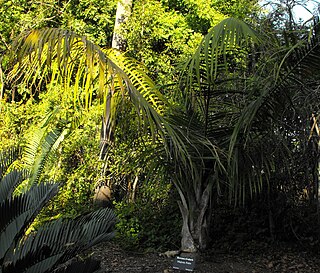
Ravenea is a genus of 20 known species of palms, all native to Madagascar and the Comoros.
Barringtonia chaniana is a species of woody plant in the family Lecythidaceae. It is found only in Pahang and Johor in Malaysia. It is found in lowlands and hill forests up to 570 m and is threatened by habitat loss.
Barringtonia maxwelliana is a species of woody plant in the Lecythidaceae family. It is endemic to Bukit Larut in Perak, Malaysia. It can be found on steep ridges and hillsides in submontane forests, at about 600 m. It is threatened by habitat loss.

Nephrosperma vanhoutteanum is a species of palm tree, and the only species in the genus Nephrosperma. It is found only in Seychelles, where it is threatened by habitat loss.
Aechmea aculeatosepala is a species of plant in the family Bromeliaceae. It is endemic to Ecuador. Its natural habitats are subtropical or tropical moist lowland forests and subtropical or tropical moist montane forests. It is threatened by habitat loss.

Aechmea wuelfinghoffii is a species of plant in the family Bromeliaceae. It is endemic to Ecuador. Its natural habitat is subtropical or tropical moist lowland forests. It is threatened by habitat loss.
Bomarea brachysepala is a species of flowering plant in the family Alstroemeriaceae. It is native to Peru and Ecuador. It grows in mountain forest habitat in the Andes. It is threatened by destruction of habitat caused by deforestation and mining.
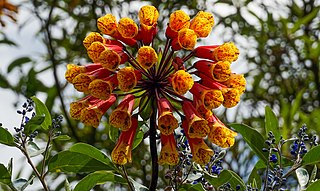
Bomarea glaucescens is a species of flowering plant in the family Alstroemeriaceae. It is native to Peru, Bolivia and Ecuador. It grows in wet páramo habitat among Polylepis and next to lakes, as well as grassy páramo and Andean forests. It is not a threatened species but some populations are vulnerable to habitat destruction as the páramo is converted to pasture and pine and eucalyptus plantations.
Bomarea goniocaulon is a species of flowering plant in the family Alstroemeriaceae. It is native to Peru and to Ecuador, where it has been collected only three times in the Pichincha Province. It is known from mountain forest habitat.
Bomarea hartwegii is a species of flowering plant in the family Alstroemeriaceae. It is native to Peru and to Ecuador, where it has only been collected twice, in the Pichincha Province. It is threatened by habitat destruction.
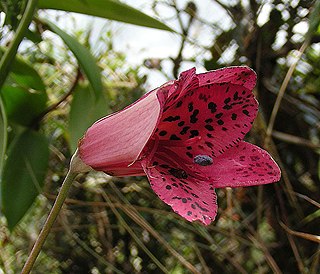
Bomarea longipes is a species of plant in the Alstroemeriaceae family. It is endemic to Peru and Ecuador. Its natural habitat is subtropical or tropical moist montane forests. It is threatened by habitat loss.
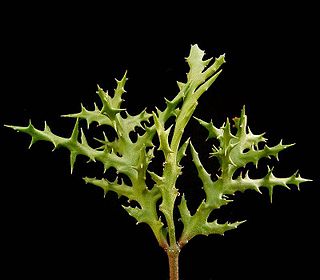
Euphorbia stenoclada is a species of plant in the family Euphorbiaceae. It is native to Madagascar and the Mozambique Channel Islands. Its natural habitats are subtropical or tropical dry forests, subtropical or tropical dry shrubland, and rocky areas. It is threatened by habitat loss.
Mapania ferruginea is a species of plant in the sedge family, Cyperaceae. It is found in Cameroon and São Tomé and Príncipe. Its natural habitat is subtropical or tropical moist montane forests. It is threatened by habitat loss.
Psidium claraense is a species of plant in the family Myrtaceae. It is endemic to Cuba. It is threatened by habitat loss.

Narcissus longispathus is a species of bulbous plant that is endemic to Spain. Its natural habitat is rivers. It is threatened by habitat loss.
Phyllanthus pavonianus, synonym Phyllanthus haughtii, is a species of plant in the family Phyllanthaceae. It is native from south Ecuador to north-west Peru. Its natural habitat is subtropical or tropical moist montane forests. Under the synonym Phyllanthus haughtii, it has been regarded as "endangered".
Phyllanthus sponiifolius is a species of plant in the family Phyllanthaceae. It is native to Colombia and Ecuador. Its natural habitat is subtropical or tropical moist montane forests.
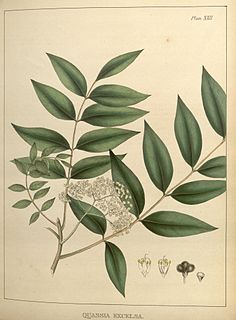
Picrasma excelsa is a species of Picrasma in the family Simaroubaceae. It is found in Cuba, the Dominican Republic, Haiti, Jamaica, Puerto Rico, Saint Vincent and the Grenadines, and Venezuela. It is threatened by habitat loss.

Narcissus viridiflorus, commonly known as campanitas, is a species of the genus Narcissus (daffodils) in the family Amaryllidaceae. It is classified in Section Jonquillae.
Narcissus bujei is a species of the genus Narcissus (daffodils) in the family Amaryllidaceae. It is classified in Section Nevadensis. The flower is a plain yellow. It is native to the Andalusia region of Spain, in particular the Comarca of Subbética (Córdoba) and the Sierra de las Nieves in the Serranía de Ronda (Málaga). It is considered an endangered species. Its preferred habitat is calcareous soils in small forests and irrigated land.










